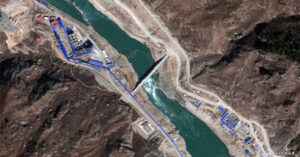 Concern is growing regarding China’s attempts to dominate water resource in Asia through its construction of dams in Tibet. Analysis of construction along the Yarlung Tsangpo [Brahmaputra] River suggest an attempt to control water supply to India through the proposed construction of eight dams. The dams raise the prospect of China using them to “cause flash flooding or to divert water that could dry up rivers across India”.
Concern is growing regarding China’s attempts to dominate water resource in Asia through its construction of dams in Tibet. Analysis of construction along the Yarlung Tsangpo [Brahmaputra] River suggest an attempt to control water supply to India through the proposed construction of eight dams. The dams raise the prospect of China using them to “cause flash flooding or to divert water that could dry up rivers across India”.
A recent investigation by India Today suggests that “China is not building a large number of dams on the Brahmaputra River for the benefit of the people of Tibet”, as the area is “scantly populated” with electricity demand likely to be met by existing projects. The report goes on to suggest water might be taken away from Tibet, with dams used “to divert Brahmaputra’s water to dry areas in Xinjiang [East Turkestan, an ethnic minority Muslim area of north west China subject to a similarly repressive régime to that of Tibet] or Central China”.
At the height of this summer’s border clashes between Chinese and Indian troops, control over water resources, namely in the Galwan valley and Pangong Lake areas, were at the heart of the conflict. Chinese forces are even accused of damming a river in the Galwan valley before “releasing a rush of water to destabilise Indian soldiers… they attacked with stones and makeshift spiked weapons”.
Away from India concern has been raised that China has deliberately sought to control the flow of the Mekong River to countries in South East Asia. In May The Nation newspaper in Thailand reported that, “researchers are worried that Chinese dams will hold back much of the water in the Mekong River this year”, a move which in 2019,“exacerbated the drought in the Northeast of Thailand, Laos, Cambodia and Vietnam”.
Though the report stopped short of suggesting China was exacerbating the droughts deliberately, additional analysis identified,“how China used its dams to stop the flow of water, as at the origin of Mekong, there was an abundance of water”. Satellite images from the time of the 2019 Mekong drought showed reservoirs in China at capacity.
An article in the Diplomat estimates that since taking power the Chinese Communist Party (CCP) has overseen the construction of more than 87,000 dams, saying that this has created the potential to generate more hydroelectric power than the capacities of Brazil, Canada and United States combined. The benefits to China’s domestic population are far from clear.
Non-Government Organisation (NGO) International Rivers estimates that 23million people have been forced from their homes and land by dam construction in China. The NGO also highlights the impact of large dam projects “on the biological, chemical and physical properties of rivers”, going so far as to describe China’s rivers as having “reached their ecological tipping point”.

File photo
In July this year authorities in Anhui province were forced to destroy a dam with explosives in an effort to alleviate flooding. Meanwhile the Chinese South China Morning Post and the Los Angeles Times have questioned the contribution of the Yangtze River’s much celebrated “Three Gorges Dam” to the worst flooding the country has seen in 20 years as communities downstream of the dam continue to struggle to cope with huge volumes of floodwater.
Researchers have noted the scarcity of information on the impact of China’s dam building campaign. Whether this is because studies have not been completed, or their findings have been obfuscated, is unclear. Ambika Vishwanath, Director of the Kubernein Initiative which tracks water diplomacy and security across the globe, describes the Himalayas as “a black hole of data”. Dechen Palmo, a research fellow at the Tibet Policy Institute, goes further describing Chinese assurances about downstream water flow following the Yarlung Tsangpo dam projects as being “largely untrue”.
“There needs to be a closer study on not just the quantity of water flow but also the quality which can be extremely detrimental in the long run. It can have an impact on people’s lives in downstream regions. There is very little information and understanding of the region”, says Vishwanath in an article in India Today. She adds that, “scientists [and] researchers need more access to the areas and require more data to understand short and long term impact to aid in better policymaking”.
China’s continued restrictions in Tibet are not allaying the concerns about the impact of water dominance in the Himalayan region will be allayed in the near future where the effects on the rivers are being felt by the people living there. It is as the impact of these policies starts to be felt beyond China’s borders that there is increasing hope that the international community will take a more forthright approach in challenging China.




 Print
Print Email
Email